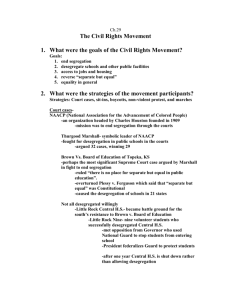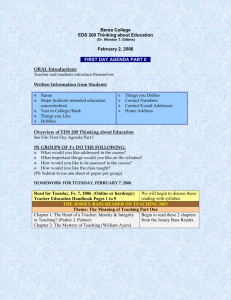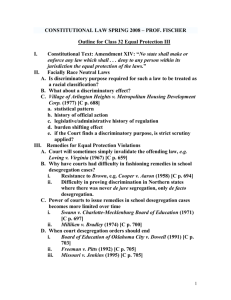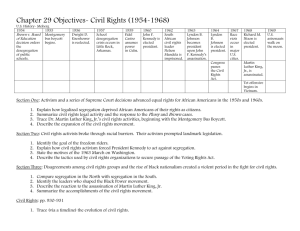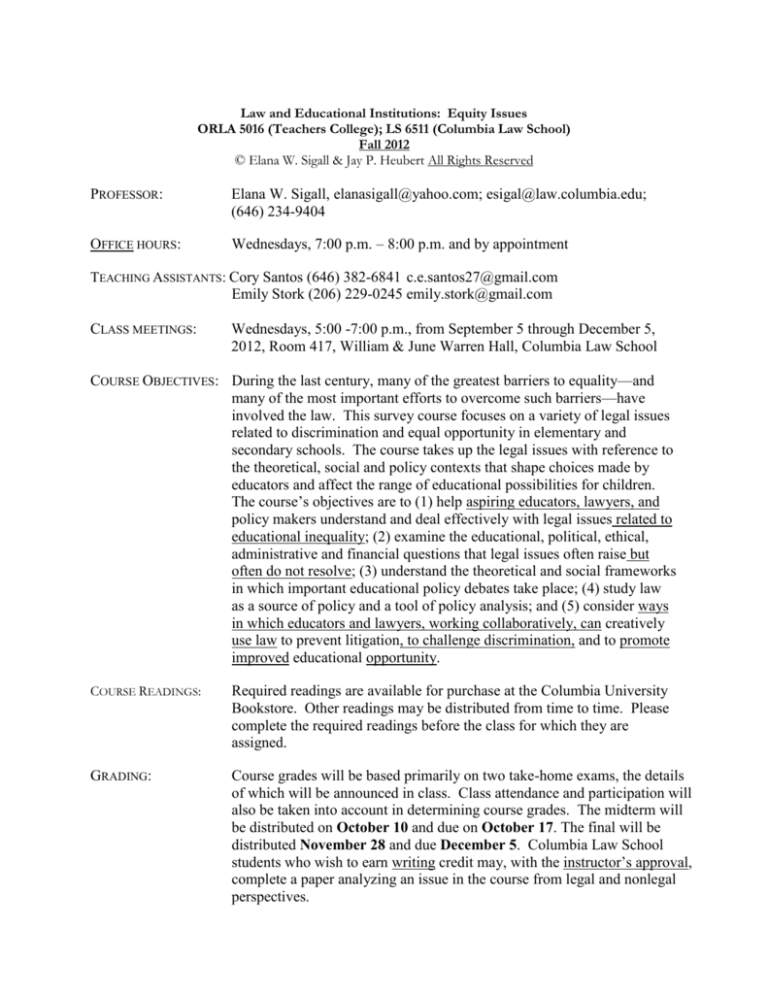
Law and Educational Institutions: Equity Issues
ORLA 5016 (Teachers College); LS 6511 (Columbia Law School)
Fall 2012
© Elana W. Sigall & Jay P. Heubert All Rights Reserved
PROFESSOR:
Elana W. Sigall, elanasigall@yahoo.com; esigal@law.columbia.edu;
(646) 234-9404
OFFICE HOURS:
Wednesdays, 7:00 p.m. – 8:00 p.m. and by appointment
TEACHING ASSISTANTS: Cory Santos (646) 382-6841 c.e.santos27@gmail.com
Emily Stork (206) 229-0245 emily.stork@gmail.com
CLASS MEETINGS:
Wednesdays, 5:00 -7:00 p.m., from September 5 through December 5,
2012, Room 417, William & June Warren Hall, Columbia Law School
COURSE OBJECTIVES: During the last century, many of the greatest barriers to equality—and
many of the most important efforts to overcome such barriers—have
involved the law. This survey course focuses on a variety of legal issues
related to discrimination and equal opportunity in elementary and
secondary schools. The course takes up the legal issues with reference to
the theoretical, social and policy contexts that shape choices made by
educators and affect the range of educational possibilities for children.
The course’s objectives are to (1) help aspiring educators, lawyers, and
policy makers understand and deal effectively with legal issues related to
educational inequality; (2) examine the educational, political, ethical,
administrative and financial questions that legal issues often raise but
often do not resolve; (3) understand the theoretical and social frameworks
in which important educational policy debates take place; (4) study law
as a source of policy and a tool of policy analysis; and (5) consider ways
in which educators and lawyers, working collaboratively, can creatively
use law to prevent litigation, to challenge discrimination, and to promote
improved educational opportunity.
COURSE READINGS:
Required readings are available for purchase at the Columbia University
Bookstore. Other readings may be distributed from time to time. Please
complete the required readings before the class for which they are
assigned.
GRADING:
Course grades will be based primarily on two take-home exams, the details
of which will be announced in class. Class attendance and participation will
also be taken into account in determining course grades. The midterm will
be distributed on October 10 and due on October 17. The final will be
distributed November 28 and due December 5. Columbia Law School
students who wish to earn writing credit may, with the instructor’s approval,
complete a paper analyzing an issue in the course from legal and nonlegal
perspectives.
Course Outline, Required Readings, and Discussion Questions
VOL. I
1. COURSE OVERVIEW; INTRODUCTION TO THE STUDY OF SCHOOL
LAW
9/5-9/12
(Required only for non-law students) Edwards, H. and Nordin, V. (1980). An
Introduction to the American Legal System. Cambridge, MA: The Institute for
Educational Management, pp. 1–24, 40–42.
Heubert, Jay, "The More We Get Together: Improving Collaboration Between
Educators and Their Lawyers." Harvard Educational Review 67(3): 531–82 (Aug.
1997).
Redfield, Sarah E., “The Convergence of Education and Law: A New Class of
Educators and Lawyers.” 36 Ind. L. Rev. 609 (2003).
Zirkel, Perry A., “The ‘Explosion’ in Education Litigation: An Update.” Education
Law Reporter, 114:341-351 (1997).
Levin, Henry and Clive Belfield (2007). The Costs and Benefits of an Excellent
Education for All of America’s Children. New York: Teachers College, Columbia
University.
Zhao, Yilu, “Beyond ‘Sweetie.’” New York Times, Nov. 7, 2004.
Questions to consider: (1) Why do educators and policy makers, especially those
concerned about equity, need to know something about law and law-related issues? (2)
Why is educator-lawyer collaboration important in advancing an equity agenda? (3) Is
litigation exploding in education? If not, in what area(s) is there increased litigation?
(4) Why read Yilu Zhao’s article at the start of a law course? (5) Are there reasons for
promoting educational equality that are grounded in economics and self-interest?
2.
9/5-9/12
RACE, NATIONAL ORIGIN, AND EDUCATION
A. The context
DIRECTIONS: Please read carefully Omi and Winant, Crenshaw, Plessy,
Kluger, Brown, and Herbert. Please skim the remaining articles.
Omi, Michael and Winant, Howard, Racial Formation in the United States: From the
1960s to the 1990s, 2nd ed. New York: Routledge (1994), pp. 53–76.
Crenshaw, Kimberle Williams, “Race, Reform, and Retrenchment: Transformation
and Legitimation in Antidiscrimination Law.” 101 Harv. L. Rev. 1331, 1370–87
(1988).
Dillon, Sam. “U.S. Data Show Rapid Minority Growth.” New York Times, June 1,
2007.
Bernstein, Nina, “Record Immigration Changing New York’s Neighborhoods.” New
York Times, Jan. 24, 2005, p. B1.
2
Zehr, Mary Ann, “Reports Spotlight Latino Dropout Rates, College Attendance.”
Education Week, Jun. 18, 2003.
Watanabe, Teresa and Wride, Nancy, “Stark Contrasts Found Among Asian
Americans.” Los Angeles Times, Dec. 16, 2004.
Wu, Frank, “Mixed Race America and the Law.” Trial, ed. Kevin R. Johnson, New
York University Press, Sep., 2003, p. 70.
Williams, Patricia, “Excluded Voices: Realities in Law and Law Reform: SpiritMurdering the Messenger: The Discourse of Fingerpointing as the Law’s
Response to Racism.” 42 U. Miami L. Rev. 127, 127–29 (1987).
Swarns, Rachel L., “Growing Unease for Some Blacks on Immigration.” New York
Times, May 4, 2006, p. A1.
Herbert, Bob, “An Emerging Catastrophe.” New York Times, Jul. 19, 2004.
Butterfield, “Prison Rates Among Blacks Reach a Peak, Report Finds.” New York
Times, Dec. 30, April 7, 2003.
Herbert, "Poisonous Police Behavior." New York Times, June 2, 2007.
Gately, Gary, “Judge Says HUD Erred on Public Housing.” New York Times, Jan. 7,
2005.
“Bias Against Indians.” New York Times, Nov. 19, 2003.
Harvard Civil Rights Project (2007). State of Segregation. Cambridge, MA: Author.
Frankenberg, E. and Orfield, G. (2006). New Research on the Segregation of American
Teachers. Cambridge: Harvard Civil Rights Project.
Dillon, Sam. “Large Urban-Suburban Gap Seen in Graduation Rates.” New York
Times, April 22, 2009, p. A1.
Olson, Lynn. “Gaps in Proficiency Levels on State Tests and NAEP Found to Grow.”
Education Week, April 18, 2007, Vol. 26, No. 2, p. 12.
Lloyd, Sterling, “State-Reported Graduation Rates at Variance with Independent
Calculations.” Education Week, June 25, 2008.
CREDO, (2009). Multiple Choice: Charter School Performance in 16 States.
Stanford, CA: Author.
Barton, Paul and Richard Coley (2007). The Family: America’s Smallest School
(Highlights). Princeton, NJ: Educational Testing Service.
Gootman, Elissa. “In Elite Schools, A Dip in Blacks and Hispanics.” New York
Times, August 18, 2006.
Gewertz, Catherine. “Black Boys’ Educational Plight Spurs Single-Gender Schools:
New Federal Rules Seen as Chance for Innovation.” Education Week, June 20,
2007, Vol. 26, No. 42, pp. 1, 24–25.
UCLA Civil Rights Project, 2007. Social Science Findings about School Integration.
Los Angeles: Author.
Plessy v. Ferguson, 163 U.S. 537 (1896) (please also read Developments from Plessy
to Brown).
Arriola, Christopher J., “A Landmark Little Noted—Until Today.” Los Angeles
Times, Apr. 14, 1997.
Kluger, Richard, Simple Justice. New York: Knopf (1975), pp. 217–26.
Brown v. Board of Education (Brown I), 347 U.S. 483 (1954).
Brown v. Board of Education (Brown II), 349 U.S. 294 (1955).
Herbert, Bob, “Regressing on Integration.” New York Times, Apr. 26, 2004.
3
Green v. New Kent County School Board, 391 U.S. 430 (1968) (from Alexander and
Alexander, American Public School Law. New York: Wadsworth Publishing Co.
(2001), pp. 511–12).
Questions to consider: (1) According to Omi and Winant, how are racial categories
“formed, inhabited, transformed, and destroyed”? What does it mean to say that race is
an “unstable and ‘decentered’ complex of social meanings constantly being
transformed by political struggle”? What are the roles of educators and lawyers in that
struggle? (2) What is the relationship between discrimination as a historical matter and
discrimination in its modern-day forms?
9/12
B. Remedies for illegal segregation
1) School desegregation within a district
Keyes v. Denver School District No. 1, 413 U.S. 189 (1973).
Orfield, Gary, Must We Bus? Washington, DC: Brookings Institution (1978), pp. 20–
21.
Swann v. Charlotte-Mecklenburg Board of Education, 402 U.S. 1 (1971), and
preceding material (from Alexander and Alexander, American Public School Law.
New York: Wadsworth Publishing Co. (2001), pp. 516-520).
Heubert, Singleton and Swann: Two Cases on Desegregation Remedies.
Questions to consider: (1) Do you think separate is inherently unequal, as the
Supreme Court says in Brown I? Or are there circumstances in which differential
treatment by race, national origin, and gender would be justified or even desirable?
What reasons do you think the Brown Court had for saying that separate is inherently
unequal? (2) Which Supreme Court decisions help define when there is a violation of
the equal protection clause, and which decisions deal with what the remedies should
be for such a violation? (3) Does the Keyes decision address de facto segregation or de
jure segregation? What’s the difference? (3) What are the remedies for illegal
segregation according to Brown II, Green, and Swann? Are those remedies sufficient
to “eliminate the vestiges of segregation root and branch?”
9/12-9/19
2) The school-housing connection
Dimond, Paul R., “The Trial of Judge Roth, Apr. to Sep., 1971.” Beyond
Busing. Ann Arbor: U. Mich. Press (1985), pp. 41–73.
Orfield, Gary, “Segregated Housing and School Resegregation.” Dismantling
Desegregation The Quiet Reversal of Brown v. Board of Education, Gary
Orfield and Susan E. Eaton, eds. New York: The New Press (1996), pp.
291–303, 309–30.
Savage, Charlie. “Justice Dept. Fights Bias in Lending.” New York Times, Jan.
14, 2010, p. A1.
Fernandez, Manny. “Bias is Seen as Landlords Bar Vouchers.” New York
Times, October 30, 2007.
4
Fessenden, Ford, “[Westchester] County Sued Over Lack of Affordable
Homes.” New York Times, February 4, 2007.Lambert, Bruce, “Suit Accuses
L.I. Land Plan of Supporting Segregation.” The New York Times, May 13,
2005.
9/19
3) Interdistrict desegregation
Milliken v. Bradley (Milliken I), 418 U.S. 717 (1974).
Missouri v. Jenkins, 515 U.S. 70 (1995).
Wells, Amy, et al. (November 2009). Boundary Crossing for Diversity, Equity,
and Achievement: Interdistrict School Desegregation and Educational
Opportunity. Cambridge, MA: Charles Hamilton Houston Institute for
Race and Justice (pages 1–9 are required).
Orfield, Gary, “The Growth of Segregation African Americans, Latinos, and
Unequal Education.” Dismantling Desegregation The Quiet Reversal of
Brown v. Board of Education, Gary Orfield and Susan E. Eaton, eds. New
York: The New Press (1996), pp. 56–57, 61–71.
Hogan and Hartson L.L.P., “Missouri v. Jenkins: The Supreme Court
Reconsiders School Desegregation in Kansas City, Criteria for Unitary
Status, and Remedies Reaching Beyond School District Lines” (1995).
Gewertz, Catherine, “A Hard Lesson For Kansas City’s Troubled Schools.”
Education Week, Apr. 26, 2000.
Hendrie, Caroline, “Magnets’ Value in Desegregating Schools is Found to be
Limited.” Education Week, Nov. 13, 1996.
Morantz, Alison, “Money and Choice in Kansas City Major Investments With
Modest Returns.” Dismantling Desegregation The Quiet Reversal of Brown
v. Board of Education, Gary Orfield and Susan E. Eaton, eds. New York:
The New Press (1996), pp. 241–63).
9/26-10/3
4) Educational remedies; state liability; unitary status
Milliken v. Bradley (Milliken II), 433 U.S. 267 (1977).
Eaton, Feldman, and Kirby, “Still Separate Still Unequal The Limits of Milliken II’s
Monetary Compensation to Segregated Schools.” Dismantling Desegregation The
Quiet Reversal of Brown v. Board of Education, Gary Orfield and Susan E. Eaton,
eds. New York: The New Press (1996), pp. 143–48, 162–66, 173–78.
Board of Education of Oklahoma City Public Schools v. Dowell 498 U.S. 237 (1991),
and preceding material (from Alexander and Alexander, American Public School
Law. New York: Wadsworth Publishing Co. (2001), pp. 520–21, 525–27).
Freeman v. Pitts, 503 U.S. 467 (1992) (from Alexander and Alexander, American
Public School Law. New York: Wadsworth Publishing Co. (2001), pp. 527–32).
Sheff v. O’Neill, 678 A.2d 1267 (Conn. 1996) (summary from Gooch, James K.,
“Fenced In: Why Sheff v. O’Neill Can’t Save Connecticut’s Inner City Students.”
22 Quinnipiac L. Rev. 395, 396 (2004)).
5
VOL. II
10/3
5) Socioeconomic Desegregation and Resegregation
Rimer, Sarah. “Schools Try Integration by Income, Not Race.” New York
Times, May 8, 2003.
Doorey, Nancy and Harter, Bruce, “From Court Order to Community
Commitment.” Educational Leadership, Dec. 2002/Jan. 2003, pp. 22–26.
Kahlenberg, Richard D., “Socioeconomic School Integration” Poverty & Race.
September/October 2001.
Orfield, Gary “Response [to Kahlenberg]” Poverty & Race. September/October
2001.
Shaw, Theodore, et. al., “Response [to Kahlenberg].” Poverty & Race.
November/December 2001, pp. 1–10.
Greenhouse, Linda. “Justices Limit the Use of Race in School Plans for
Integration.” New York Times, June 29, 2007, p. A1.
NAACP Legal Defense and Educational Fund, Decision Summary (2007).
Parents Involved in Community Schools v. Seattle School Dist. No. 1 et al., 127
S.Ct. 2738 (2007) (The opinions by Chief Justice Roberts, Justice Kennedy,
and Justice Breyer are historic. Please read at least a portion of each one.)
You can find the decision and opinions at:
http://www.supremecourtus.gov/opinions/06pdf/05-908.pdf.
Ryan, James. (2008). “The Supreme Court and Voluntary Desegregation.”
Harvard Law Review 121:131.
National Academy of Education (2007). Race-Conscious Policies for Assigning
Students to Schools: Social Science Research and Supreme Court Cases.
Washington, DC: Author.
Wells, Amy and Erica Frankenberg, “The Public Schools and the Challenges of
the Supreme Court’s School Desegregation Decision.” Phi Delta Kappan,
November 2007, pp. 177–88.
Dillon, Sam, “Alabama Plan Brings Outcry of Resegregation.” New York Times,
September 17, 2007.
Cohen, Adam, “The Supreme Struggle.” New York Times, Jan. 18, 2004.
Sunstein, Cass, “Did Brown Matter?” The New Yorker, May 3, 2004.
Winter, Greg, “Long After Brown v. Board of Education, Sides Switch.” New York
Times, May 16, 2004.
Bell, Derrick, Silent Covenants: Brown v. Board of Education and the Unfulfilled
Hopes for Racial Reform. Oxford: Oxford University Press (2004), pp. 20–28,
130–37, 194–201.
Lee, Chungmei, “Is Resegregation Real?” The Civil Rights Project, Harvard
University (Oct. 2004).
6
VOL. III
3. STANDARDS, ASSESSMENTS, ACCOUNTABILITY: A NEW CIVIL
RIGHT?
10/10
A. Overview: Origins of large-scale testing in the U.S.
Kamin, The Science and Politics of IQ. Potomac, MD: L. Erlbaum Associates (1974),
pp. 5–30.
B. Appropriate use of tests that have high stakes for individual students
National Research Council (1999). “Findings and Recommendations.” High
Stakes: Testing for Tracking, Promotion, and Graduation pp. 273–307.
Washington D.C.: National Academy Press
The Education Trust. (May 2003). The Unfinished Business of Brown v. Board of
Education: While It Still Takes Place in the Same Building, Education is Still
Separate and Still Unequal. Washington, DC: Author.
C. Legal challenges where test programs have high stakes for individual
students
Taylor, W. “Standards, Tests, and Civil Rights.” Education Week, November 15,
2000.
National Research Council, Heubert and Hauser, eds. “Legal Frameworks.”
High Stakes: Testing for Tracking, Promotion, and Graduation. Wash.,
DC: Nat'l Academy Press (1999), pp. 50–70 (only pages 50–54 and 63–65
are required).
Heubert, J. (2005). High-stakes testing, nationally and in the South. In Edley, C.,
G. Orfield, and J. Boger, eds., School Resegregation: Must the South Turn
Back? Chapel Hill: University of North Carolina Press, 221–38 (legal portion
only).
Note: Materials on assessment of English-language learners and students with
disabilities appear in subsequent sections.
D. The standards movement; graduation testing and promotion testing
Darling-Hammond, L & Falk, B. (1997). “Using Standards and Assessments to
Support Student Learning” Phi Delta Kappan, pp.190–199.
Center on Education Policy, (August 2005). State High School Exit Exams: States
Try Harder, But Gaps Persist. Washington DC: Author, pp. 1–7.
Urbana, Ian. “As School Exit Tests Prove Tough, States Ease Standards.” New
York Times, January 12, 2010, p. A1.
E. Mixed Data on Student Achievement and Graduation Rates
7
Jennings, Jack. (Nov. 5, 2009). CEP Report on High School Exit Exams Shows
Improvement in Passage Rates. Washington, DC: Center on Education
Policy.
Dillon, Sam. “Large Urban-Suburban Gap Seen in Graduation Rates.” New York
Times, April 22, 2009, p. A1.
Lloyd, Sterling, “State-Reported Graduation Rates at Variance with Independent
Calculations.” Education Week, June 25, 2008.
Ravitch, Diane. “Mayor Bloomberg’s Crib Sheet.” New York Times, April 10,
2009.
Schemo. D. “Grades Rise, but Reading Skills Do Not.” New York Times, February
23, 2007.
Schemo, “Most Students in Big Cities Lag Badly in Basic Science.” New York
Times, Nov. 16, 2006.
Viadero, “Condition of Education Finds Surge in Minorities’ AP Test Taking.”
Education Week, May 31, 2007.
4. ENGLISH-LANGUAGE LEARNERS: LAW, POLICY, AND PRACTICE
10/17
A. Language barriers: the scope of the challenge
Dillon, S. “U.S. Data Show Rapid Minority Growth in School Rolls. New York
Times, June 1, 2007.
Robinson, Virginia, “Children in Immigrant Families.” InFocus., Center for
Health and Health Care in Schools, Feb. 25, 2005, available at
http://www.health inschools.org/focus/2005/no1.htm.
Olson, Lynn, “Mixed Needs of Immigrants Pose Challenges for Schools.”
Education Week, Sept. 27, 2000.
B. Educational programs for English-language learners: Debate and
research
Education Week Research Center (2007). “English-Language Learners.”
Education Week.
Crawford, J. (2004). “Chapter 5: Evolution of Federal Policy.” Educating English
Learners. Language Diversity in the Classroom, 5th Ed. Los Angeles:
Bilingual Educational Services, pp. 105–130 (skim).
Goldenberg, C. (2007). Improving Achievement for English Learners:
Conclusions from Recent Reviews and Emerging Research. California State
University, Long Beach: Author (skim).
Resnick, L., ed. (Winter 2004). English-Language Learners: Boosting Academic
Achievement. American Educational Research Association.
Zehr, Mary Ann, “Two-Way Language Immersion Grows in Popularity.”
Education Week, Feb. 16, 2005.
Ford, Richard Thompson, “Brown at Fifty: Brown’s Ghost.” 117 Harv. L. Rev.
1305 (2004) (skim).
8
Gándara, P., & Contreras, F. (2009). “Is language the problem” in The Latino
education crisis: The consequences of failed social policies. Cambridge,
MA: Harvard University Press.
Zehr, M.. “NCLB Seen as Damper for Bilingual Program. Education Week,
May 9, 2007.
C. Legal issues
Plyler v. Doe, 457 U.S. 202 (1982).
Zehr, M. “High Court’s School Access Ruling Endures as a Quiet Fact of Life.”
Education Week, June 6, 2007.
Castillo, Juan, “Tuition Law for Illegal Immigrants Challenged.” Austin
American Statesman, Feb. 1, 2005.
Freedman, Samuel G., “Behind Top Student’s Heartbreak, Illegal Immigrants’
Nightmare.” New York Times, Sept. 1, 2004.
Lau v. Nichols, 414 U.S. 563 (1974).
Castaneda v. Pickard, 648 F.2d 989 (5th Cir. 1981).
Horne v. Flores, __ U.S. __, Slip Op., No. 08-289 (June 25, 2009) (only the
syllabus is required).
Zehr, Mary Ann, “Appellate Court Upholds California Bilingual Law.”
Education Week, Oct. 16, 2002.
U.S. Dept. of Education, “Testing of Limited-English Proficient Students.” The
Use of Tests When Making High-Stakes Decisions for Students (Dec. 2000).
10/24
5. SCHOOL-FINANCE REFORM; THE RIGHT TO AN ADEQUATE
EDUCATION
Olson, Lynn, “New Jonathan Kozol Book Dramatizes ‘Savage’ Inequalities in
Urban Schools.” Education Week, Sept. 25, 1991.
Hanuschek , E. (2006). “Funding for Performance: A Policy Statement of the
Koret Task Force,” in Courting Failure how School Finance lawsuits
Exploit Judges Good Intentions and Harm our Children, Stanford, CA:
Education Next Books, pp. 329–55.
Rebell, Michael and Joseph Wayland (2009). “CFE v. State of New York:
Ensuring a Meaningful High School Education for All Students,” in Long, et
al., eds., A Quality Education for Every Child: Stories from the Lawyers on
the Front Lines. Washington, DC: Institute for Educational Equity and
Opportunity, pp. 33–67.
Rebell, Michael. “Safeguarding the Right to a Sound Basic Education in Times
of Fiscal Restraint. School Funding News, Feb. 19, 2010.
Rebell, Michael (2009). “Educational Policy and the Courts,” in Rebell, Courts
and Kids: Pursuing Educational Equity through the State Courts. Chicago:
University of Chicago Press, pp. 9–58.
9
6. SEX AND GENDER DISCRIMINATION AND RELATED ISSUES
11/7–11/14
A. Theory and Difference and Crisis
Harris, Angela P. “Race and Essentialism in Feminist Legal Theory.” 42 Stan. L.
Rev. 581, 585–92, 602–05, 608–16 (1990).
Kimmel, Michael, “What Are Little Boys Made Of?” in Richardson, Taylor, and
Whittier, eds., Feminist Frontiers, 6th Ed. New York: McGraw Hill (2004), pp.
166–69.
Tyre, Peg. “The Trouble With Boys.” Newsweek, Jan. 30, 2006.
Whitmire, Richard. “Boy Trouble.” The New Republic, Jan. 23, 2006.
Hulbert, Ann, “Will Boys Be Boys.” Slate, Feb. 1, 2006.
Warner, Judith, “What Boy Crisis.” The New York Times, Jul. 3, 2006.
Warner, Judith, “What Girls Ought to Learn From Boys in ‘Crisis.’” The New York
Times, Jul. 12, 2006.
Jennifer Delahunty Britz, To All the Girls I Have Rejected, New York Times, March
23, 2006.
Gewertz, Catherine, “Foundation Tackles Black Males’ School Woes.” Education
Week, Dec. 8, 2004.
Crozier, Patience W., “Book Review: Forcing Boys to Be Boys: The Persecution of
Gender Non-Conforming Youth: The War Against Boys: How Misguided
Feminism is Harming Our Young Men. By Christina Hoff Sommers.” 21 B.C.
Third World L.J. 123 (2001).
Risman, Barbara, “Ideology, Experience, Identity: The Complex Worlds of Children
in Fair Families” in Richardson, Taylor, and Whittier, eds., Feminist Frontiers, 6th
Ed. New York: McGraw Hill (2004), pp. 169–80.
B. Gender Gap?
Viadero, Debra. “Researchers Mull STEM Gender Gap.” Education Week, June
17, 2009, pp. 1, 15.
Robelen, Erik. “Boys Trail Girls in Reading Across States.” Education Week,
March 17, 2010, Vol. 29, Issue 27.
Angier, Natalie, and Chang, Kenneth, “Gray Matter and the Sexes: Still a
Scientific Gray Area.” New York Times, Jan. 24, 2005.
Strauss, Valerie, “Decoding Why Few Girls Choose Science, Math.” Washington
Post, Feb. 1, 2005.
Dean, Cornelia, “For Some Girls, the Problem with Math Is That They’re Good at
It.” New York Times, Feb. 1, 2005.
McNamara, Melissa P., “In Fighting Stereotypes, Students Lift Test Scores.” New
York Times, Jan. 20, 2004.
AAUW, “Tech-Savvy: Educating Girls in the New Computer Age (2000),”
available at http://www.aauw.org/research/girls_education/techsavvy.cfm.
Bartow, Ann, “Still Not Behaving Like Gentlemen.” 49 Kan. L. Rev. 809, 835–38
(2001).
Quillen, Ian. “College Board Report Examines State of Minority Male Students.”
Education Week, February 3, 2010, p. 10.
10
C.
Case Law
Mississippi University for Women v. Hogan, 458 U.S. 718 (1982).
United States v. Virginia, 518 U.S. 515 (1996)
Jackson v. Birmingham Board of Education, 125 S. Ct. 1497 (2005) (syllabus).
D.
Title IX: History and Update: Sex Segregation
Davis, Michelle R., “Title IX Review Concludes with Competing Reports.” Education
Week, Mar. 5, 2003.
Manning, James F., “Additional Clarification of Intercollegiate Athletics Policy:
Three-Part Test—Part Three,” Mar. 17, 2005, available at
http://www.ed.gov/about/offices/list/ocr/docs/title9guidanceadditional.html.
Davis, Michelle R., “Rules on Single-Sex Education Allow Room to Experiment.”
Education Week, Mar. 10, 2004.
Gross, Jane, “A Coed School Offers Boys and Girls Separate Classes in Grades 6–8.”
New York Times, May 31, 2004.
Davis, Michelle R., “Federal Study Examining Single-Sex Public Schools.”
Education Week, Mar. 24, 2004.
Williams, Verna L., “Reform or Retrenchment?: Single-Sex Education and the
Construction of Race and Gender.” 2004 Wis. L. Rev. 15 (2004) (excerpted)
(emailed out to the class).
Salomone, Rosemary C., Same, Different, Equal. New Haven: Yale University Press
(2003), pp. 167–187.
Hedlund, Randy, “Segregation by Any Other Name: Harvey Milk High School.” 33
J.L. & Educ. 425 (2004).
34 C.F.R. § 106.34 (2006).
Diana Jean Schemo, Federal Rules Back Single-Sex Public Education, New York
Times, Oct. 25, 2006, at A1.
Title IX revised regulations, 34 C.F.R. § 106.34 (2006).
11
VOL. IV
10/31
7.
DISABILITY ISSUES
A. Special education
Board of Education v. Rowley, 458 U.S. 176 (1982) (syllabus).
Irving Independent School District v. Tatro, 104 S. Ct. 3371 (1984) (syllabus).
Greenhouse, Linda, “Court Says Schools Must Pay For Needs of Disabled Pupils.
New York Times, March 4, 1999 [Garrett F.].
Berger, J. “Fighting Over When Public Should Pay Private Tuition for Disabled.”
New York Times, Mar. 21, 2007.
Zobrest v. Catalina Foothills School District, 113 S. Ct. 2462 (1993) (summary).
Forest Grove School Dist. v. T.A., __U.S.__, Slip Op., No. 08-305 (June 22, 2009)
(syllabus).
Mass. Dept. of Education (Dec. 1, 2006). “Advisory on Schaffer v. Weast, U.S.
Supreme Court Decision on Burden of Proof in Special Education Appeals Cases.”
U.S. Dept. of Education, Office of Special Education Programs. (10/04/06). “IDEA
Regulations: IEP Team Meetings and Changes to IEP.”
Honig v. Doe, 484 U.S. 305 (1988) (syllabus).
U.S. Dept. of Education, Office of Special Education Programs. “IDEA Regulations:
Discipline.”
Situation: Special Education Discipline (Please be prepared to discuss this.)
Samuels, C. “California Students with Disabilities Face Exit Exam.” Education
Week, May 23, 2007.
U.S. Dept. of Education, Questions and Answers About Provisions in the IDEA
Related to Students with Disabilities and State and District-Wide Assessments
(Aug. 24, 2000).
Sheehan, Susan, “The Autism Fight.” The New Yorker, Dec. 1, 2003.
Ferri, Beth A. and Connor, David J., “Special Education and the Subverting of
Brown.” 8 J. Gender Race & Just. 57 (2004).
Weiss, Kenneth R., “New Test-Taking Skill: Working the System.” Los Angeles
Times, Jan. 9, 2000.
B.
Special education implementation issues
Samuels, C. “Minority Overrepresentation in Special Education Targeted.”
Education Week, Oct. 12, 2005.
U.S. Dept. of Education, Office of Special Education Programs. (2/2/07).
“IDEA Regulations: Disproportionality and Over-Identification.”
Belkin, Lisa, “The Lessons of Classroom 506.” New York Times, Sep. 12, 2004.
Samuels, C. “Ed. Dept. Backs Research Plans for RTI Method.” Education
Week, Nov. 8, 2006.
Walser, N. “Response to Intervention.” Harvard Education Letter (Jan.-Feb.
2007).
Curtis, S.E. “Parents and Litigation: Insights from a Special Education Law
Clinic.” Phi Delta Kappan (March 2005).
12
McLaughlin, Margaret (November 2006). Closing the Achievement Gap and
Students with Disabilities: The New Meaning of a ‘Free and Appropriate
Education. Paper presented at the Campaign for Educational Equity
National Symposium Examining America’s Commitment to Closing
Achievement Gaps. New York: Teachers College, Columbia University.
11/28
8.
EMPLOYMENT DISCRIMINATION/HARASSMENT
Griggs v. Duke Power, 401 U.S. 424 (1971).
Ricci v. DeStefano, Nos. 07-1428 and 08-328 (U.S. 2009).
Situation: Harassment (Please be prepared to discuss this.)
Meritor v. Vinson, 477 U.S. 57 (1986) (summary).
Harris v. Forklift Systems, Inc., 510 U.S. 17 (1993).
Burlington Industries v. Ellerth, 118 S. Ct. 2257 (1998) (syllabus and following
summary).
Oncale v. Sundowner Offshore Services, Inc., 523 U.S. 75 (1998) (summary from
Lanctot, Catherine J., “The Plain Meaning of Oncale.” 7 Wm. & Mary Bill of
Rts. J. 913, 918-922 (1999)).
Greenhouse, Linda, “Rules are Set for Some Harassment Cases.” New York Times,
Jun. 15, 2004.
Equal Employment Opportunity Commission, Regulations Against Harassment
(1999).
Hotvedt, et al (Feb. 3, 1992) “The Civil Rights Act of 1991.” Education Law
Reporter, Vol. 73, pp. 361-367.
Talbot, Margaret, “Men Behaving Badly.” New York Times, Oct. 13, 2002.
Liptak, Adam. “Court Expands Ability to Sue in Sexual Harassment
Investigations.” New York Times, Jan. 27, 2009, p. A1.
Gebser v. Lago Vista Indep. School Dist., 118 S. Ct. 1989 (1998) (syllabus).
Davis v. Monroe County Bd. Of Ed., 119 S. Ct. 1661 (1999) (syllabus).
Greenhouse, Linda, “Sex Harassment in Class is Ruled Schools’ Liability.” New
York Times, May 25, 1999.
Office for Civil Rights, U.S. Dept. of Education, Revised Sexual Harassment
Guidance: Harassment of Students by School Employees, Other Students, Or
Third Parties, pp. 1-11 (May 30, 2001).
Office for Civil Rights, U.S. Dept. of Education, Checklist for a Comprehensive
Approach to Dealing with Harassment (May 30, 2001).
AAUW, “Hostile Hallways: Bullying, Teasing, and Sexual Harassment in School
(2001),” available at
http://www.aauw.org/research/girls_education/hostile.cfm.
Jacobson, L., “Wash. District Settles Lawsuit Over Treatment of Black Students.”
Education Week, Sep. 25, 2002.
Gootman, Elissa, “City to Help Curb Harassment of Asian Students at High
School.” New York Times, Jun. 2, 2004.
Zehr, Mary Ann. “Complaint Says Phila. District ‘Indifferent’ to Harassment of
Asians.” Education Week, January 26, 2010, pp. 6-7.
“Gay Student Settles Lawsuit Against NY District.” Teacher Magazine, March
29, 2010.
13
Carpenter, Mackenzie, “Gays, Lesbians and School Bullies: Advocates Say
Educators Are Far Too Reluctant to Tackle What They See as a Widespread
Problem.” Pittsburgh Post-Gazette, Feb. 20, 2005.
Walsh, Mark, “Three Districts Pay Damages in Gay-Rights Lawsuits.” Education
Week, Sep. 4, 2002.
“Dealing with Legal Matters Surrounding Students’ Sexual Orientation and
Gender Identity” by a coalition of education organizations led by the National
School Boards Association, available at
http://www.nsba.org/site/docs/34600/34527.pdf.
ACLU, “Adding Sexual Orientation & Gender Identity to Discrimination &
Harassment Policies in School,” available at
http://www.aclu.org/safeschools/glsen.html.
So, Suyin, “Sexual Harassment in Education.” 4 Geo. J. Gender & L. 351 (2002).
U.S. Dept. of Education, Reminder: Harassment Based on Disability is Wrong,
Illegal (May 24, 2001).
Fine, Lisa, “District’s Anti-Harassment Policy Too Broad, Court Rules.”
Education Week, Feb. 28, 2001.
Emily Bazelon, “What Really Happened to Phoebe Prince.” Slate, July 20, 2010.
12/5
9. AFFIRMATIVE ACTION
Regents of the University of California v. Bakke, 438 U.S. 265 (1978) (summarized—
will be emailed to the class).
Chappell, David L., “If Affirmative Action Fails . . . What Then?” New York Times,
May 8, 2004.
Bowen, William G. and Bok, Derek, “Merit and the Relevance of Race in College
Admissions.” Los Angeles Times, Sep. 23, 1998.
Glazer and Thernstrom, “Should the SAT Account for Race?” New Republic, Sep. 27,
1999, pp. 26-33.
Traub, James, “The Pull of Family.” New York Times, Feb. 29, 2004.
Summary of Supreme Court affirmative action decisions from the 1980s and 1990s.
“Excerpts From the U.S. Supreme Court’s Jun. 2003 Affirmative Action Decisions:
Grutter v. Bollinger (5-4) and Gratz v. Bollinger (6-3).” Full decisions available at
Grutter v. Bollinger, 123 S. Ct. 2325 (2003) and Gratz v. Bollinger, 123 S. Ct.
2411 (2003)].
“Freshman Enrollment.” Education Week, Oct. 27, 2004.
Guinier, Lani, “The ‘Quota’ Smokescreen.” The Nation, Feb. 10, 2003.
Walsh, Mark, “Justices Give K-12 Go-Ahead to Promote Diversity.” Education Week,
Jul. 9, 2003.
Keller, Bess, “Ban on Affirmative Action Gets Closer to Mich. Ballot.” Education
Week, Jan. 19, 2005.
Leonhardt, David, “As Wealthy Fill Top Colleges, Concerns Grow Over Fairness.”
New York Times, Apr. 22, 2004.
Williams, Patricia, “The Obliging Shell: An Informal Essay on Formal Equal
Opportunity” in Gates, E. Nathaniel, ed., The Judicial Isolation of the “Racially”
Oppressed. New York: Garland Publishing, Inc. (1997), pp. 142-165.
14
Arenson, Karen W., “Access Denied: Economics and the Elite.” New York Times,
Apr. 24, 2005.
Karabel, Jerome, “The Legacy of Legacies.” New York Times, Sep. 13, 2004.
Rimer, Sara and Arenson, Karen W., “Top Colleges Take More Blacks, but Which
Ones?” New York Times, Jun. 24, 2004.
Glater, Jonathan D., “Diversity Plan Shaped in Texas Is Under Attack.” New York
Times, Jun. 13, 2004.
15
This course addresses the following NCATE/ELCC accreditation standards:
6.1 Building leadership:
Legal systems shape schools, communities, and educational opportunities
Effects of poverty, disability, language barriers, and discrimination on families, children,
learning
How federal, state, and local laws affect schools and educational opportunity
6.1 School district leadership:
Policies, laws, and regulations affecting a specific district
System for public-school financing and its effect on equitable distribution of opportunity
Effects of specific laws on school districts and residents.
6.2 School district leadership
Apply understanding of social, legal, and political context to develop activities and policies that
benefit districts and students
6.3 Building leadership
Engage community; apply understanding of legal and political context to benefit students and
families.
5.1 and 5.2 (Both levels)
Respect for the rights of others with regard to confidentiality and dignity
Impartiality, sensitivity to diversity, and ethical considerations in their interactions
Make and explain decisions based on ethical and legal principles
4.2 (Both levels)
Advocate for students with special needs
4.2 (Building leadership)
Build on community diversity to improve programs and meet needs of all students
3.1 (Both levels)
Apply legal principles that promote educational equity and provide safe facilities
16


